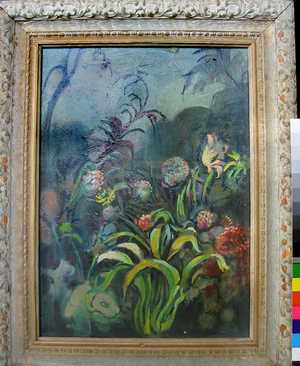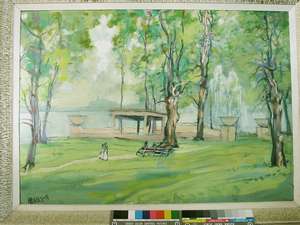1884-1963
Jerry Nelson
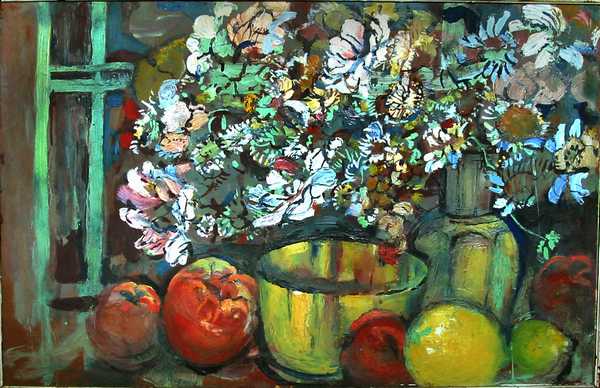
#11 Still life. Flower profusion in octagonal faceted vase w/
tomatoes and lemons. Unsigned. 15 x 23 1/2
Frieda
Perlzweig gave me the following 13 artworks from Grandpa Harry in
February 2005.
Annoyed with
Frieda, Florence Nelson threw them out of her house in February 2006.
I preserved images of them all, and found new homes for some.
There are better works by Harry than these. In
years ahead, I hope to visit his paintings and the people who own them,
and bring home more photos.
click any
image to enlarge
(left) #1 Jungle of garden flowers. Unsigned. 15 3/4 x 11 1/2
Taken by Lydia.
(right) #2 Landscape. Chartreuse green park scene. Signed.
Paint is thin, flat (not reflective). 19 1/4 x 27 1/4 x
Taken by Krystyna Grynberg's son Adam.
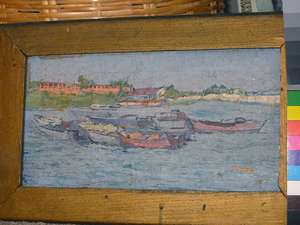
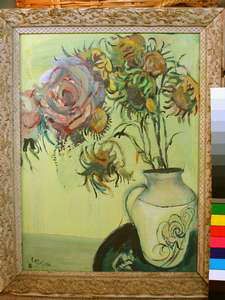
click any image to enlarge
(left) #3 Water. Moored row of boats, low orange bldg. Unsigned.
Dirty, cracked surface. 6 3/4 x 12 in
Taken by Lydia.
(right) #4 Still life of sunflower & rose in white pitcher vase.
Chartreuse cast. Paint thin, flat. 15 1/2 x 11 3/4
Taken by Robin 2005.
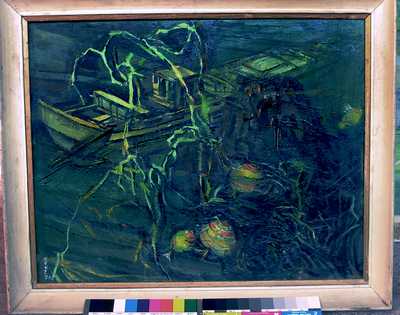
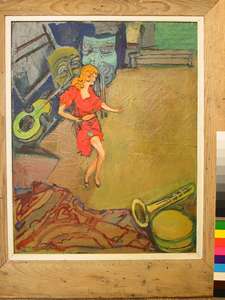
click any image to enlarge
#5 Fantasy of sunken ship, citadel & 4 bright fish.
Signed. 15 1/4 x 19 1/2
Taken by Lydia.
#6 Dancer in red, backstage. Unsigned. 19 1/2 x 15 1/2
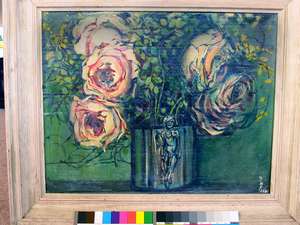
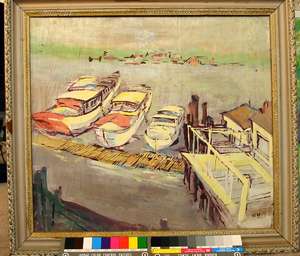
click any image to enlarge
#7 Still life. 5 roses in metallic cylinder w/nude handle.
Signed. Oil on paper; others mostly Beaverboard or wooden panels. 15 1/2 x 19 1/2
Taken by Tina Gourd Nelson & Lorrin Nelson, 2005.
#8 Water. 3 moored boats & pier. Signed w/initials.
Paint thin, dull. 16 1/2 x 18 3/4
Taken by Marie Green, 2005 (Flo&Gil Nelson's house cleaner)
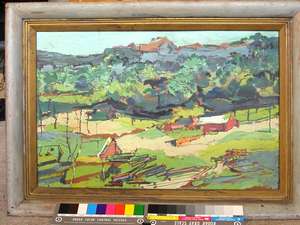
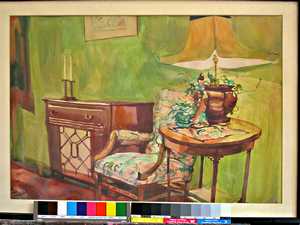
click any image to enlarge
#9 Landscape w/small farm bldgs, felled timber, horse & wagon. Unsigned. 12 x 18 1/2
Taken by Marie Green, 2005.
#10 Interior. End table, lamp, chair, sideboard. Unsigned.
Wash, matted & framed under glass. 13 1/2 x 19
Taken by Lorrin & Tina 2005.
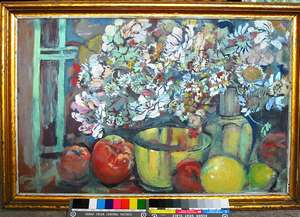
#11 Still life. Flower profusion in octagonal faceted vase w/
tomatoes and lemons. Unsigned. 15 x 23 1/2
Taken by Lorrin & Tina.
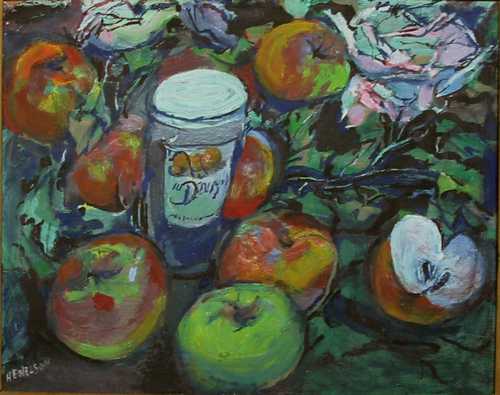
click any image to enlarge
#12 Still life. 2 roses, jam jar and apples, one cut open.
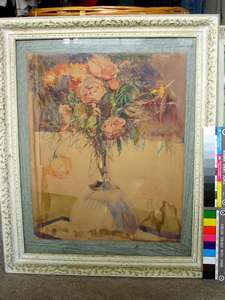
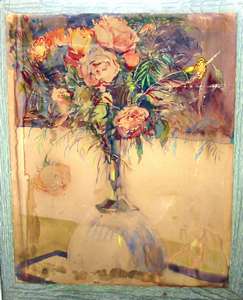
click any image to enlarge
#13 Still life. Carnations in metal-necked glass vase. Unsigned.
Wash on browned paper, water stained on vertical edges, under glass w/broken corner. 16 3/4 x13 1/2
Taken by Lydia.
(left: original. right: enhanced)
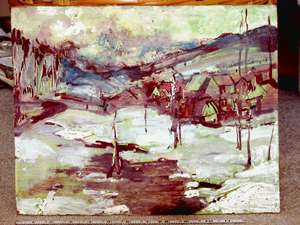
click image to enlarge
Winter scene: village nestled against gentle hill, stream in foreground.
Unsigned.
Oil on quarter-inch plywood. 11 x 14 in
Feb 06. Was over Dad's basement workbench.
Taken by Lydia.
The paintings from Frieda make a sorry impression. Most have a blue-green or other cast because he painted that way and/or some pigments are less permanent than others. When it says "dirty cracked surface" on the list, believe me, it's true.
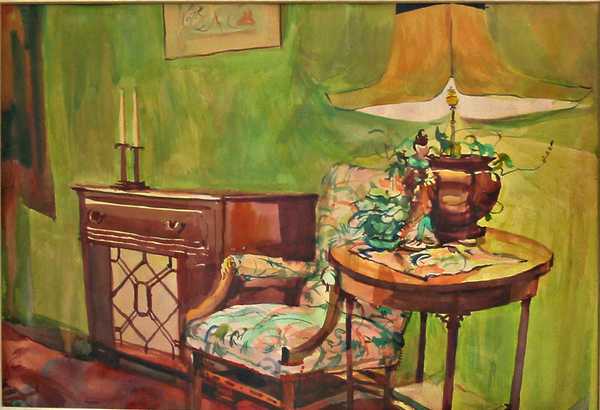
FRIEDA PERLZWEIG (1914-2007)
Frieda was my key living link to Nelson family history (the paternal side of my family). Many photos and the conversations with Frieda about those photos have enriched my life.
Family legend (i.e., Frieda Perlzweig) places Harry at his father Elias's feet in Russia on Sundays, watching his grandfather Yitzak make tea in a big samovar heated with charcoal. When tea time was over, Yitzak gave Harry the leftover charcoal. He began drawing with the charcoal -- the first drawings he ever did. Sometime after the age of 6, he immigrated to the United States. As for Yitzak, he was exiled to Siberia on "the blood libel", the Czarist charge that the Jews had killed a Gentile boy to make matzos with his blood. But Yitzak managed to die in Israel and is buried in the Mt. Herman Cemetery in Jerusalem.
The Perlzweig children have many of Harry's paintings, because Frieda cleaned out his basement apartment when he died (1963). Harry was Frieda's uncle. Dad (Gilbert) was posted to Rome at the time and flew home, but couldn't easily claim and ship the paintings. Harry was Gil's father. Possession is nine-tenths of ownership. As time passes, it should be possible to photograph the better works and add their images here. Ownership is easy, sharing is harder.
THE NELSON KIDS
Florence Laikind Nelson and Gilbert Isaac Nelson's four children were Jerry, David, Edward and Lydia. Jerry and Robin's son Lorrin (& Tina) Nelson have some of Harry's paintings.
MARIE GREEN
was Florence & Gil's cleaning lady for many years.
KRYSTYNA GRYNBERG
was a neighbor and dear friend of Florence and Gil Nelson. In her native Poland, she quit training as a young ballerina to become a nationally known movie actress before immigrating to the U.S. Her (former) husband Henryk Grynberg's Wikipedia bio http://en.wikipedia.org/wiki/Henryk_Grynberg does not mention their life together.
GENEALOGY NOTES
Harry Nelson (1884 - 1963) is the grandfather of Lydia, Edward (& Gemma), David (& Arlene) and Jerry (& Robin) Nelson through his son Gilbert (1914-2004) and Florence (1916-2007) Nelson. Harry's only other child, Evelyn Valentine Nelson (Valentine's Day 1911 - August 1922) died in childhood.
EVELYN VALENTINE NELSON -- St. Vitus Dance is a strep infection
Dad's sister died at age 11 of St. Vitus Dance, or Sydenham's Chorea or Rheumatic Chorea. It affects girls more often boys, typically between the ages of 7 and 14. Many victims get over it. The symptoms are initial weakness of the limbs, followed by involuntary jerking movements. Attack is more likely in the summer and early autumn.
It was mistakenly thought until the mid-1900s to be a children's version of Huntington's chorea, a progressive dementia that eventually kills the sufferer. In fact, St. Vitus Dance is caused by streptococcal infections starting in the throat or on the skin (boils), that are inadequately treated. Evelyn's mother Jenny became a Christian Scientist after her daughter's death. Thus, her faith did not speed her daughter's demise, but my father writes of his mother, "She remained an increasingly devoted member to the end of her life. She died in the summer of 1944 of cancer in the crown of her head. This was preceded by a long period of refusing non-Christian Science medical help."
Evelyn was kept out of the house, ill, for a year and a half or longer, so Gil, who was 3 years younger, had little chance to get to know her. Since his father set out to teach his piano lessons to students coming home from school, Gil never found his own father at home when he himself returned home.
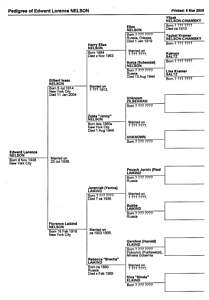
(left) #1 Jungle of garden flowers. Unsigned. 15 3/4 x 11 1/2
Taken by Lydia.
(right) #2 Landscape. Chartreuse green park scene. Signed.
Paint is thin, flat (not reflective). 19 1/4 x 27 1/4 x
Taken by Krystyna Grynberg's son Adam.


click any image to enlarge
(left) #3 Water. Moored row of boats, low orange bldg. Unsigned.
Dirty, cracked surface. 6 3/4 x 12 in
Taken by Lydia.
(right) #4 Still life of sunflower & rose in white pitcher vase.
Chartreuse cast. Paint thin, flat. 15 1/2 x 11 3/4
Taken by Robin 2005.


click any image to enlarge
#5 Fantasy of sunken ship, citadel & 4 bright fish.
Signed. 15 1/4 x 19 1/2
Taken by Lydia.
#6 Dancer in red, backstage. Unsigned. 19 1/2 x 15 1/2


click any image to enlarge
#7 Still life. 5 roses in metallic cylinder w/nude handle.
Signed. Oil on paper; others mostly Beaverboard or wooden panels. 15 1/2 x 19 1/2
Taken by Tina Gourd Nelson & Lorrin Nelson, 2005.
#8 Water. 3 moored boats & pier. Signed w/initials.
Paint thin, dull. 16 1/2 x 18 3/4
Taken by Marie Green, 2005 (Flo&Gil Nelson's house cleaner)


click any image to enlarge
#9 Landscape w/small farm bldgs, felled timber, horse & wagon. Unsigned. 12 x 18 1/2
Taken by Marie Green, 2005.
#10 Interior. End table, lamp, chair, sideboard. Unsigned.
Wash, matted & framed under glass. 13 1/2 x 19
Taken by Lorrin & Tina 2005.

#11 Still life. Flower profusion in octagonal faceted vase w/
tomatoes and lemons. Unsigned. 15 x 23 1/2
Taken by Lorrin & Tina.

click any image to enlarge
#12 Still life. 2 roses, jam jar and apples, one cut open.
Predominantly
blue-green. Beaver board . 15
1/4 x19
1/4
Taken by Jerry 2005.
Taken by Jerry 2005.


click any image to enlarge
#13 Still life. Carnations in metal-necked glass vase. Unsigned.
Wash on browned paper, water stained on vertical edges, under glass w/broken corner. 16 3/4 x13 1/2
Taken by Lydia.
(left: original. right: enhanced)

click image to enlarge
Winter scene: village nestled against gentle hill, stream in foreground.
Unsigned.
Oil on quarter-inch plywood. 11 x 14 in
Feb 06. Was over Dad's basement workbench.
Taken by Lydia.
The paintings from Frieda make a sorry impression. Most have a blue-green or other cast because he painted that way and/or some pigments are less permanent than others. When it says "dirty cracked surface" on the list, believe me, it's true.
---=o0&0o=---

Harry
E Nelson - 10 - Interior End Table Lamp, Chair,
Sideboard 13 1/2 x 19 in, watercolor, unsigned
Harry
Nelson earned his living as a commercial artist for New York City
newspapers-- the Pulitzer "World" and the Hearst "Journal".
He engraved plates to illustrate news stories and
advertisements in the early 1900s, when there was no
way to
print photos -- with their many shades of gray -- using a
printing press that had only a single shade of jet black ink.
PIANISTS AND PIANO TEACHERS. Half-tone technology put an end to engraved newspaper illustrations, and Harry earned a living for most of his life as a piano teacher -- not as well known as his pianist sister, Nellie Nelson (1888-1973), who was Irving Berlin's secretary until she herself hit the Vaudeville Circuit and eventually played in every state of the lower 48. Nor was Harry as schooled as his pianist brother Abe, for whom the family scraped up enough money for a stint at a German conservatory. Abe Nelson, ca 1879 - ca 1962, studied at the Stern Conservatory, Berlin ca 1905 with Lusatitsky, one of two students of Franz Liszt on the faculty. The other was Martin Krause, who trained Edwin Fischer and Claudio Arrau.
HALF-TONE TECHNOLOGY. As for the half-tone technology that cost my grandfather his job, the black ink has not changed to this day, but glass plates were invented, covered by nothing but hundreds of pinholes per square inch. Each pinhole makes a small, blurry circle of light of a brightness appropriately proportional to the brightness (grayness) of the image at that place. As a whole and from afar, the picture would look normal to you, but just a whole lot dimmer. Intensity lost and nothing gained, you say? Wrong. The trick is the blurriness of each little pool of light. If we expose a very high contrast photographic film to this image, only the tippy tops of the dim dots will be bright enough to make an exposed spec on the film, but the bright dots will expose the film all the way out to their blurry bottoms. Eureka! Shades of graded gray intensity have been translated into dots of graded diameters. As a whole and from afar, an image printed with only jet black ink will take on all shades of gray.
The glass plate is called the half-tone screen. The screen is ruled (scratched) with scores or even hundreds of lines per inch with a diamond in at least two directions -- hey, it's only a checkerboard, but it functions like pinholes. The scratches block the light, and the unscratched spots or checkerboard checks are the "pinholes" that let the light through. The blurriness of each dot of light results not just from the fact that there is no lens to focus anything (we started with a flat plate of glass, could have been a window pane), but also from the wave nature of light. Lots of light makes a bigger blurry circle of light, that's the key. While people running billion-dollar astronomical telescopes and multi-million dollar spy satellites gnash their teeth over their diffraction-limited optics, we have built a technology out of diffraction-driven blur that supports the world's printing industries. Half-tone screening has nothing to do with "Ben-day Dots", which are pre-printed in uniform diameters to make uniform tones for comic books, pop art and Roy Lichtenstein.
To get the dots right (bigger ones in the dark shadows), printers will "half-tone" a negative by copying the negative, not the original picture, with the screen-and-film sandwich, and that dotty copy is used to etch or burn a printing press plate. For example, if you made a Xerox of the dotty copy onto a sheet of plastic or plastic coated paper, you could slap that copy onto a press and make thousands of prints -- each of the thousands of rough little dots would pick up the ink and the plastic would repel it everywhere else. Voila, a printing press plate.
PIANISTS AND PIANO TEACHERS. Half-tone technology put an end to engraved newspaper illustrations, and Harry earned a living for most of his life as a piano teacher -- not as well known as his pianist sister, Nellie Nelson (1888-1973), who was Irving Berlin's secretary until she herself hit the Vaudeville Circuit and eventually played in every state of the lower 48. Nor was Harry as schooled as his pianist brother Abe, for whom the family scraped up enough money for a stint at a German conservatory. Abe Nelson, ca 1879 - ca 1962, studied at the Stern Conservatory, Berlin ca 1905 with Lusatitsky, one of two students of Franz Liszt on the faculty. The other was Martin Krause, who trained Edwin Fischer and Claudio Arrau.
HALF-TONE TECHNOLOGY. As for the half-tone technology that cost my grandfather his job, the black ink has not changed to this day, but glass plates were invented, covered by nothing but hundreds of pinholes per square inch. Each pinhole makes a small, blurry circle of light of a brightness appropriately proportional to the brightness (grayness) of the image at that place. As a whole and from afar, the picture would look normal to you, but just a whole lot dimmer. Intensity lost and nothing gained, you say? Wrong. The trick is the blurriness of each little pool of light. If we expose a very high contrast photographic film to this image, only the tippy tops of the dim dots will be bright enough to make an exposed spec on the film, but the bright dots will expose the film all the way out to their blurry bottoms. Eureka! Shades of graded gray intensity have been translated into dots of graded diameters. As a whole and from afar, an image printed with only jet black ink will take on all shades of gray.
The glass plate is called the half-tone screen. The screen is ruled (scratched) with scores or even hundreds of lines per inch with a diamond in at least two directions -- hey, it's only a checkerboard, but it functions like pinholes. The scratches block the light, and the unscratched spots or checkerboard checks are the "pinholes" that let the light through. The blurriness of each dot of light results not just from the fact that there is no lens to focus anything (we started with a flat plate of glass, could have been a window pane), but also from the wave nature of light. Lots of light makes a bigger blurry circle of light, that's the key. While people running billion-dollar astronomical telescopes and multi-million dollar spy satellites gnash their teeth over their diffraction-limited optics, we have built a technology out of diffraction-driven blur that supports the world's printing industries. Half-tone screening has nothing to do with "Ben-day Dots", which are pre-printed in uniform diameters to make uniform tones for comic books, pop art and Roy Lichtenstein.
To get the dots right (bigger ones in the dark shadows), printers will "half-tone" a negative by copying the negative, not the original picture, with the screen-and-film sandwich, and that dotty copy is used to etch or burn a printing press plate. For example, if you made a Xerox of the dotty copy onto a sheet of plastic or plastic coated paper, you could slap that copy onto a press and make thousands of prints -- each of the thousands of rough little dots would pick up the ink and the plastic would repel it everywhere else. Voila, a printing press plate.
FRIEDA PERLZWEIG (1914-2007)
Frieda was my key living link to Nelson family history (the paternal side of my family). Many photos and the conversations with Frieda about those photos have enriched my life.
Family legend (i.e., Frieda Perlzweig) places Harry at his father Elias's feet in Russia on Sundays, watching his grandfather Yitzak make tea in a big samovar heated with charcoal. When tea time was over, Yitzak gave Harry the leftover charcoal. He began drawing with the charcoal -- the first drawings he ever did. Sometime after the age of 6, he immigrated to the United States. As for Yitzak, he was exiled to Siberia on "the blood libel", the Czarist charge that the Jews had killed a Gentile boy to make matzos with his blood. But Yitzak managed to die in Israel and is buried in the Mt. Herman Cemetery in Jerusalem.
The Perlzweig children have many of Harry's paintings, because Frieda cleaned out his basement apartment when he died (1963). Harry was Frieda's uncle. Dad (Gilbert) was posted to Rome at the time and flew home, but couldn't easily claim and ship the paintings. Harry was Gil's father. Possession is nine-tenths of ownership. As time passes, it should be possible to photograph the better works and add their images here. Ownership is easy, sharing is harder.
THE NELSON KIDS
Florence Laikind Nelson and Gilbert Isaac Nelson's four children were Jerry, David, Edward and Lydia. Jerry and Robin's son Lorrin (& Tina) Nelson have some of Harry's paintings.
MARIE GREEN
was Florence & Gil's cleaning lady for many years.
KRYSTYNA GRYNBERG
was a neighbor and dear friend of Florence and Gil Nelson. In her native Poland, she quit training as a young ballerina to become a nationally known movie actress before immigrating to the U.S. Her (former) husband Henryk Grynberg's Wikipedia bio http://en.wikipedia.org/wiki/Henryk_Grynberg does not mention their life together.
GENEALOGY NOTES
Harry Nelson (1884 - 1963) is the grandfather of Lydia, Edward (& Gemma), David (& Arlene) and Jerry (& Robin) Nelson through his son Gilbert (1914-2004) and Florence (1916-2007) Nelson. Harry's only other child, Evelyn Valentine Nelson (Valentine's Day 1911 - August 1922) died in childhood.
EVELYN VALENTINE NELSON -- St. Vitus Dance is a strep infection
Dad's sister died at age 11 of St. Vitus Dance, or Sydenham's Chorea or Rheumatic Chorea. It affects girls more often boys, typically between the ages of 7 and 14. Many victims get over it. The symptoms are initial weakness of the limbs, followed by involuntary jerking movements. Attack is more likely in the summer and early autumn.
It was mistakenly thought until the mid-1900s to be a children's version of Huntington's chorea, a progressive dementia that eventually kills the sufferer. In fact, St. Vitus Dance is caused by streptococcal infections starting in the throat or on the skin (boils), that are inadequately treated. Evelyn's mother Jenny became a Christian Scientist after her daughter's death. Thus, her faith did not speed her daughter's demise, but my father writes of his mother, "She remained an increasingly devoted member to the end of her life. She died in the summer of 1944 of cancer in the crown of her head. This was preceded by a long period of refusing non-Christian Science medical help."
Evelyn was kept out of the house, ill, for a year and a half or longer, so Gil, who was 3 years younger, had little chance to get to know her. Since his father set out to teach his piano lessons to students coming home from school, Gil never found his own father at home when he himself returned home.

Here is a
genealogy snippet - click it for a legibly-enlarged copy.
I would be
happy to have more dates (your marriage, dates for child,
whatever). Thanks.
Where's Harry? On the chart, find Elias and Sonja Nelson. Their children included Frieda Perlzweig's mother, and her brother Harry. The children of Elias and Sonja were:
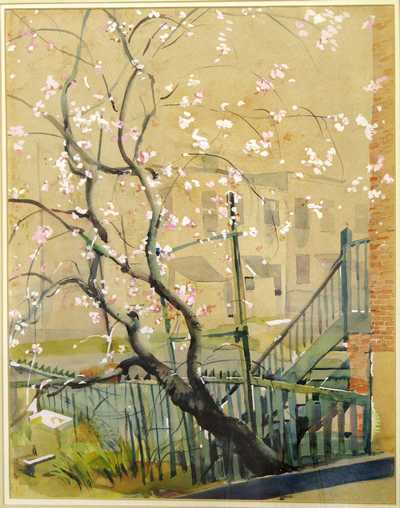
click image to enlarge
Harry E Nelson - The Artist's Backyard with Cherry Blossoms. 1950s 16 x 13 in, watercolor
Taken by Robin & Jerry Nelson
--jerry
6March2005; Rev 25Apr08; 12May08
Where's Harry? On the chart, find Elias and Sonja Nelson. Their children included Frieda Perlzweig's mother, and her brother Harry. The children of Elias and Sonja were:
- the beautiful Esther Nelson Rich (ca 1874- ?);
- Abe Nelson (ca 1879 - ca 1962), the great pianist whom the family struggled to send to a German conservatory for study. Gil Nelson says they should have sent Nellie instead;
- Harry
Elias Nelson
(1884- Nov 1963); gave up work as a commercial artist and
turned to teaching piano instead so that he could paint
whatever
he wanted.
- Nadia "Nettie" Nelson (ca 1886-1948) Frieda's mother, widowed in the Great Spanish Flu Pandemic;
- Newman Nelson (no dates), mentally ill, don't know with what, but I'm sure we've all inherited it;
- Nellie Nelson (1888 - Aug 1973), worked for Irving Berlin, then quit to tour on her own in the Vaudeville circuit and performed in every State in the Lower 48;
- Frances Nelson, 25Dec1890 - ?), read every book ever published, according to Frieda.

click image to enlarge
Harry E Nelson - The Artist's Backyard with Cherry Blossoms. 1950s 16 x 13 in, watercolor
Taken by Robin & Jerry Nelson
top of
this page - Harry Nelson's art
middle of this page - bio notes
Florence Nelson's art
Isabel Field
home for entire Website
middle of this page - bio notes
Florence Nelson's art
Isabel Field
home for entire Website
6March2005; Rev 25Apr08; 12May08
